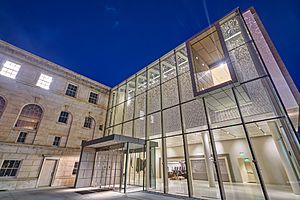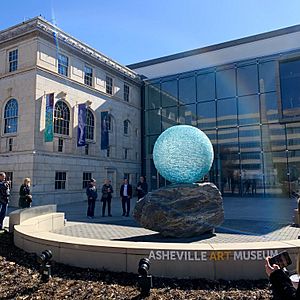Asheville Art Museum facts for kids
The Asheville Art Museum is a special place in Western North Carolina (WNC). It's a non-profit organization, which means it's not trying to make money. This museum is like a trusted friend in the art world, approved by the American Alliance of Museums. You can find it right in the heart of downtown Asheville, at 2 South Pack Square.
The museum shows off amazing American art from the 1900s and 2000s. They have special exhibits and fun programs based on their own collection. The museum features artists from both the local area and across the country. It also highlights important art from Western North Carolina's history. This includes art from Studio Craft, Black Mountain College, and Cherokee artists. They offer educational programs for both children and adults.
Contents
History of the Museum
Early Beginnings
The Asheville Art Museum started in 1948. Its first home was a small, three-room building on Charlotte Street. This building used to be an office for E.W. Grove, who built the famous Grove Park Inn. By 1950, the museum began collecting its own art.
Soon, the museum had too much art for its small space. So, it moved to a bigger spot on the 15th floor of the Northwestern Bank Building. This building is now called the BB&T Building. Later, the museum had to move again. It bought a property at 152 Pearson Drive in the Montford Area Historic District of Asheville. At this new location, the museum started showing more art from the local region. More people visited, and more programs were offered. However, the building was 40 years old and had some issues.
Moving to Bigger Spaces
In 1972, plans for the Asheville Civic Center were announced. The museum decided to become one of the cultural groups in this new center. In 1976, the museum opened a 9,000 square foot space in the Civic Center. In 1984, the Asheville Art Museum earned a special approval called accreditation. This meant it met high standards for museums.
In 1992, the museum moved into a building that was built in 1925. This building has an Italian Renaissance style, with modern additions. It used to be the Pack Memorial Library. This new location gave the museum 12,000 square feet of space. It was part of the Pack Place Education, Arts & Science Center complex in downtown Asheville.
A small expansion happened in 1999. This added more space from Pack Place and a nearby building. It created new classrooms, an art library, and a special area for teachers. There was also a community gallery and a new entrance. After this expansion, the museum had 24,400 square feet of space.
Recent Expansion and Awards
Between September 2016 and November 2019, the museum grew even more. It expanded into space that used to be used by The Health Adventure. This made the museum's total size 54,000 square feet! During this time, the museum's art collection also grew a lot. It now has over 8,000 works of art.
The museum officially reopened on November 14, 2019. The first public art piece in the plaza is a six-foot wide glass orb. It's called "Reflections on Unity" and was made by artist Henry Richardson.
In June 2022, the Asheville Art Museum received a big honor. It was one of only three museums to win the 2022 National Medal for Museum and Library Service. This award came from the Institute of Museum and Library Services.
Museum Leaders
The museum was started in 1948 by local artists. Its first full-time director was James E. Neumann, hired in 1965. He left in 1966, and F. Edward Barnwell took over. In 1970, Richard Van Kleeck became director. He helped the museum move to its Montford District location. Walter B. Elcock III was hired as director in 1971.
Thomas (Tom) Gilmartin became director in 1973 and served until 1977. After him, Mary Alice Young became the museum's first female director. When she left in 1979, Carolyn Williams was the acting director for a short time.
After a six-month search, the museum hired Edwin (Ed) Ritts, Jr. in 1980. During his time as director until 1995, the museum achieved its accreditation. It also started showing art from beyond the local area. The museum moved to Pack Place and grew its staff. Since December 1995, Pamela L. Myers has been the museum's director.



